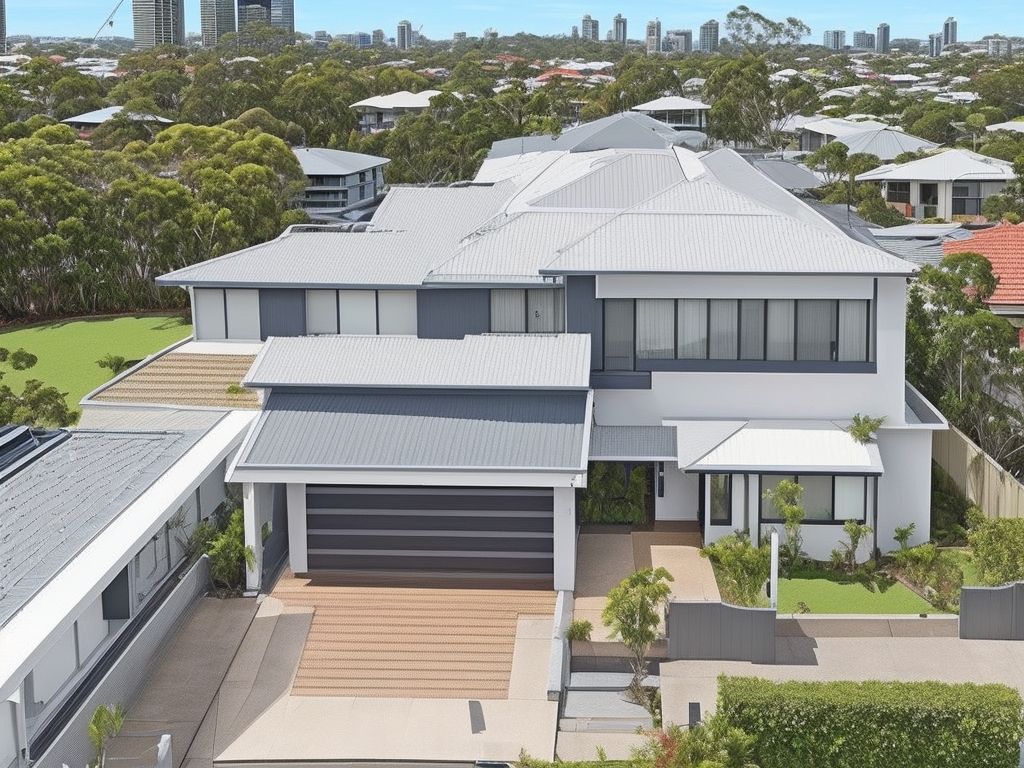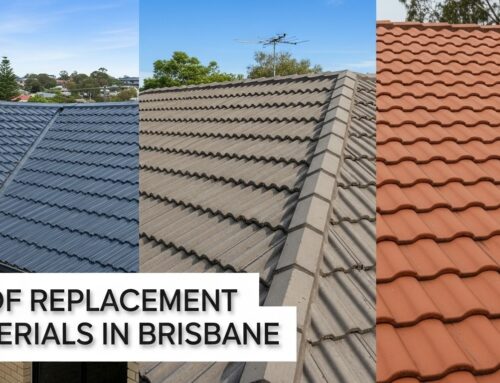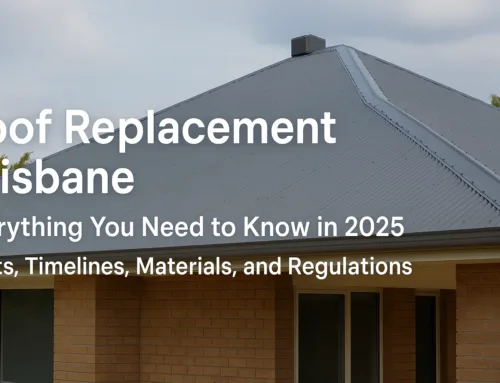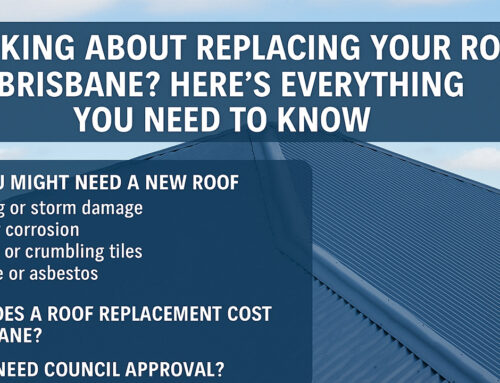The cost of a roof replacement in Brisbane can vary depending on several factors. It is important to understand these factors to get a detailed breakdown of the expenses involved. The following are the main factors that affect the cost of roof replacement:
- Type of Roofing Material: Different roofing materials have varying costs. The choice of material will depend on factors such as durability, aesthetics, and budget.
- Size and Complexity of the Roof: The size and complexity of the roof play a significant role in determining the cost. A larger roof or a roof with multiple angles and slopes will require more materials and labor, thus increasing the cost.
- Roof Pitch and Accessibility: The pitch or slope of the roof can affect the difficulty of the installation process. Steeper roofs may require additional safety measures and specialized equipment, which can add to the overall cost. Accessibility to the roof also affects the time and effort required for the replacement.
- Existing Damage or Repairs Needed: If there is existing damage or repairs required, such as rotted decking or damaged underlayment, it can increase the cost of the replacement as these issues will need to be addressed before the new roof can be installed.
It is also essential to consider the costs of different roofing materials available. Some options commonly used in Brisbane include:
- Asphalt Shingles: Affordable and widely used, asphalt shingles are a popular choice for residential properties.
- Metal Roofing: Durable and long-lasting, metal roofing comes in various styles and can withstand harsh weather conditions.
- Slate Roofing: Known for its elegance and longevity, slate roofing is a premium option that requires expert installation.
- Tile Roofing: Available in different materials like clay or concrete, tile roofing offers durability and aesthetic appeal.
Additional costs to consider during roof replacement include the removal of old roofing materials, replacement of roof decking, underlayment installation, flashing and ventilation, gutter replacement, and permits and licenses.
To get an accurate cost estimate, it is advisable to contact multiple roofing contractors and obtain detailed quotes. Researching and selecting reputable contractors is crucial to ensure quality workmanship and reliable service.
By understanding the factors affecting roof replacement costs, exploring different roofing materials and their associated expenses, and considering additional costs involved, you can make an informed decision and plan your budget accordingly for a successful roof replacement in Brisbane.
Factors Affecting Roof Replacement Cost
Wondering what influences the cost of a roof replacement in Brisbane? Let’s uncover the key factors that come into play. From the type of roofing material to the size and complexity of the roof, we’ll explore how these factors impact the cost. We’ll delve into the role of roof pitch and accessibility, as well as the significance of existing damage or repairs needed. Get ready to gain insight into the various elements that contribute to the price tag of a roof replacement in Brisbane.
Type of Roofing Material
The cost of roof replacement in Brisbane is significantly influenced by the type of roofing material chosen. The cost of different roofing materials varies depending on their durability, lifespan, and aesthetic appeal.
- Asphalt shingles: This is the most common and cost-effective roofing material option, providing adequate protection from the elements.
- Metal roofing: Metal roofs are durable and long-lasting, albeit more expensive than asphalt shingles. They offer excellent protection and energy efficiency.
- Slate roofing: Known for elegance and longevity, slate roofs are one of the most expensive options available.
- Tile roofing: Tile roofs are popular due to their durability and aesthetic appeal. They are available in clay or concrete and tend to be slightly more expensive than asphalt shingles.
When choosing a roofing material, it is important to consider your budget, the climate in your area, and the architectural style of your home. Consulting with a professional roofer is advisable to determine the most suitable material for your needs.
To obtain accurate quotes for roof replacement, it is recommended to contact multiple roofing contractors and compare their rates. Consider not only the cost of materials but also labour rates and installation fees. Thoroughly researching and selecting reputable contractors is crucial to ensure a high-quality and cost-effective roof replacement.
Size and Complexity of the Roof
The size and complexity of the roof are important factors that determine the cost of a roof replacement.
– Roof size: The larger the roof, the more materials and labour will be required for the replacement. It is important to accurately measure the size of the roof to get an estimate of the cost.
– Roof complexity: A roof with a simple design and minimal obstacles, such as chimneys or skylights, will be easier to replace and may be less expensive. A roof with multiple angles, dormers, or other intricate features will require more time and effort, which can increase the cost.
Pro-tip: Before obtaining quotes from roofing contractors, ensure you provide them with accurate information about the size and complexity of your roof. This will help them provide a more precise estimate and avoid any surprises later on.
Roof Pitch and Accessibility
When it comes to the cost of roof replacement in Brisbane, the roof pitch and accessibility are important factors to consider. Here are some key points regarding roof pitch and accessibility:
- Roof Pitch: The pitch or slope of a roof can significantly impact the cost of replacement. Steeper roofs with a higher pitch may require additional safety measures and equipment, which can increase labour and material expenses.
- Accessibility: The accessibility of the roof also affects the cost. If the roof is easily accessible and has no obstructions, it makes the installation process smoother and more efficient. If the roof is difficult to access or has obstacles such as chimneys or skylights, it may require extra time and effort from the roofing contractors, which can increase the overall cost.
- Safety measures: Steeper roofs may require a higher level of safety precautions for workers, such as harnesses or scaffolding, which can add to the labour cost.
- Material requirements: The roof pitch may affect the type of roofing material that can be installed. Some materials may not be suitable or recommended for roofs with a steep pitch, and alternative options may need to be considered, potentially impacting the cost.
Considering the roof pitch and accessibility, it is crucial to consult with professional roofing contractors who can assess these factors and provide accurate quotes for the roof replacement cost in Brisbane.
Existing Damage or Repairs Needed
Existing damage or repairs needed is an important factor to consider when it comes to roof replacement. The extent of the damage or repairs required can greatly impact the cost and timeframe of the project.
- Leakage and water damage: If your roof has existing leaks or water damage, it may require extensive repairs or even replacement of certain sections.
- Mould or rot: If there is mould or rot present on the roof, it will need to be addressed before a new roof can be installed.
- Structural damage: If there is any structural damage to the roof, such as sagging or weakened supports, it will need to be repaired or replaced.
- Missing shingles or tiles: If there are missing or damaged shingles or tiles, they will need to be replaced to ensure the integrity of the new roof.
- Flashing issues: Damaged or deteriorated flashing around chimneys, vents, or skylights may need to be repaired or replaced.
- Previous poor installation: If the existing roof was not installed properly, it may require additional repairs and adjustments to ensure a proper installation of the new roof.
It is essential to thoroughly assess and address any existing damage or repairs needed before proceeding with a roof replacement project. This will help ensure that the new roof is installed on a solid and stable foundation, and that any potential issues are resolved before they become more costly problems.
Roofing Material Options and Their Costs
When considering roof replacements in Brisbane, it is important to think about the choice of roofing materials and their associated costs. This section will provide a closer look at the various options available, such as asphalt shingles, metal roofing, slate roofing, and tile roofing. Each sub-section will explore the unique characteristics and price ranges of these materials, giving you the necessary insights to make an informed decision for your roofing project. Let’s now delve into the captivating world of roofing materials and uncover the costs involved.
Asphalt Shingles
When considering roofing options, asphalt shingles are a popular choice due to their affordability and durability. They are widely used in the roofing industry because of their easy installation process, which allows contractors to lay them efficiently, resulting in lower labour costs and shorter installation times.
Asphalt shingles are available in different styles, including three-tab, architectural, and designer shingles, offering various aesthetic preferences. The cost of asphalt shingles can vary depending on the specific style chosen. On average, the cost of asphalt shingles can range from £50 to £150 per square metre, including both materials and installation.
One of the main advantages of asphalt shingles is their ability to withstand different weather conditions. They are designed to resist strong winds and are highly waterproof, protecting roofs from rain and snow. Asphalt shingles are known for their durability, with a lifespan of 20 to 30 years with proper maintenance.
It is important to note that the lifespan of asphalt shingles can be influenced by factors such as climate and the quality of the shingles. Regular inspections and repairs are necessary to ensure the longevity of an asphalt shingle roof.
In summary, asphalt shingles are a cost-effective and durable option for roofing projects. Their ease of installation, wide range of styles, and ability to withstand various weather conditions make them an attractive choice for homeowners.
Metal Roofing
Metal roofing is a popular choice for roof replacement due to its durability and long lifespan. Here are some important factors to consider when selecting metal roofing:
- Material options: Metal roofing is available in various materials such as steel, aluminium, and copper, each with its own advantages and price range.
- Lifespan: Metal roofs have an average lifespan of 40 to 70 years, which is significantly longer compared to other roofing materials.
- Cost: The cost of metal roofing varies depending on the material and the size of the roof. On average, metal roofing can cost between £8 and £15 per square foot.
- Energy efficiency: Metal roofs are known for their energy efficiency as they reflect sunlight, reducing heat absorption and lowering cooling costs.
- Resistance: Metal roofs are highly resistant to elements such as fire, wind, and hail. They are also resistant to rot, mildew, and pests.
For example, my friend had a metal roof installed on his house. During a severe storm, several trees fell on his roof. While the trees caused extensive damage, the metal roof remained intact with minimal damage. This incident demonstrated the durability and resilience of metal roofing.
Slate Roofing
When considering slate roofing for a roof replacement, there are several important factors to keep in mind:
- Longevity: Slate roofing is known for its exceptional durability and longevity. It can easily last for over 100 years, making it a worthwhile investment.
- Natural beauty: Slate is a natural stone material that comes in a variety of colours and textures. It adds a unique and elegant look to any home.
- Fire resistance: Slate is a non-combustible material, making it highly fire-resistant. This adds an extra layer of safety and protection to your home.
- Low maintenance: Slate roofing requires minimal maintenance compared to other roofing materials. It is resistant to rot, fungus, and pests.
- Environmental friendliness: Slate is a natural, eco-friendly roofing option. It is recyclable and does not contribute to landfill waste.
Tile Roofing
Tile roofing is a popular choice for homeowners in terms of its durability and aesthetic appeal. The materials used for tiles typically include clay, concrete, or slate. Here are some important factors to consider when it comes to tile roofing:
1. Longevity: Tile roofing can last for 50 years or more, making it a long-term investment for homeowners.
2. Cost: The cost of tile roofing can vary depending on the type of material used. Concrete tiles are generally more affordable than clay or slate tiles.
3. Maintenance: Tile roofs require minimal maintenance. It is important to regularly inspect the tiles for cracks or damage and promptly repair them to prevent water leakage.
4. Insulation: Tile roofing provides excellent insulation, helping to keep the home cool in summer and warm in winter. This can potentially lead to energy savings.
5. Aesthetics: Tile roofing offers a wide range of colours, shapes, and textures, allowing homeowners to choose a style that complements the architecture of their home.
6. Weather Resistance: Tile roofs are known for their ability to withstand harsh weather conditions, including strong winds, hail, and fire.
7. Environmental Impact: Tile roofing is often considered an environmentally friendly option as it is made from natural materials and can be recycled at the end of its lifespan.
When considering tile roofing, it is important to consult with a professional roofer to assess the suitability of your roof structure and to obtain accurate cost estimates.
Additional Costs Involved in Roof Replacement
When it comes to roof replacement in Brisbane, there are more factors to consider than just the basic cost. In this section, we will explore the additional factors that can impact the overall expenses. These factors include the removal of old roofing materials, the installation of underlayment, flashing, and ventilation, each of which has its own associated costs. We will also discuss the importance of permits and licences, as well as the value of obtaining detailed quotes. So, let’s delve into the details of the extra expenses involved in a roof replacement.
Removal of Old Roofing Materials
When it comes to the removal of old roofing materials, there are several important steps to consider:
- Assess the condition of the existing roof to determine if removal is necessary. This can be done by inspecting for signs of damage or wear and tear.
- If removal is required, hire a professional roofing contractor to ensure the process is done safely and efficiently.
- Obtain a detailed quote from the contractor, specifying the cost of removing the old roofing materials. This quote should include labour rates, disposal fees, and any additional charges for specialised equipment or tools.
- Prepare the area by clearing away any obstacles or debris to provide easy access for the removal crew.
- Once the removal process begins, the contractor will carefully strip away the old roofing materials, working from the top down.
- Old tiles, shingles, or other materials will be carefully removed and placed into a designated disposal container or truck.
- Ensure that all removed materials are safely transported and disposed of in accordance with local regulations and environmental standards.
- After the old roofing materials have been removed, the contractor may perform an inspection of the roof deck to assess its condition and determine if any repairs or replacements are needed.
By following these steps and hiring a professional contractor, you can ensure a smooth and efficient removal of old roofing materials during a roof replacement project.
Roof Decking Replacement
When considering roof replacement, it is important to take into account the roof decking replacement. The condition of the roof decking can impact the overall cost and lifespan of the new roof.
- Inspect the roof decking: Before replacing the roof decking, a thorough inspection should be conducted to assess its condition. This involves checking for signs of rot, water damage, or structural issues.
- Determine the extent of replacement: Depending on the inspection, the roof decking may require partial or complete replacement. If only certain sections are damaged, those specific areas can be targeted for replacement.
- Select suitable materials: The choice of materials for the roof decking replacement should be based on factors such as the climate, budget, and desired durability. Common options include plywood, OSB (oriented strand board), or specialized decking materials.
Considering the roof decking replacement is crucial for a successful roof replacement project, ensuring a sturdy and long-lasting roof.</>
Underlayment Installation
Underlayment Installation or sarking is a crucial step in the process of replacing a roof. Here is a detailed breakdown of the steps involved:
- Prepare the roof surface: Before installing the underlayment, it is important to ensure that the roof surface is clean, dry, and free from debris or protrusions. This will create a smooth and stable base for the underlayment.
- Measure and cut the underlayment: Accurate measurements of the roof area should be taken to determine the required amount of underlayment. A utility knife or shears can be used to cut the underlayment into appropriate sections.
- Start from the bottom: The underlayment installation should begin at the bottom edge of the roof. It should be secured in place using roofing nails or staples, following the manufacturer’s guidelines for proper spacing and fastener placement.
- Overlap the underlayment: Each subsequent row of underlayment should overlap the previous row by a few inches. This overlapping ensures that water does not seep through the gaps.
- Seal the seams: A waterproof sealant or tape should be applied along the seams of the underlayment to create a watertight barrier. This helps prevent water from penetrating beneath the underlayment.
- Around penetrations and edges: The underlayment should be carefully cut and fitted around roof penetrations such as vents and chimneys. It should be secured tightly and appropriate sealants should be used to ensure a watertight seal.
- Inspect and repair: Once the underlayment is installed, the entire roof surface should be visually inspected for any visible damage or imperfections. Any damaged sections should be repaired or replaced before proceeding further.
Following these steps will complete the underlayment installation process, providing an additional layer of protection for the roof and ensuring its longevity.
Flashing and Ventilation
Flashing and ventilation are vital aspects of a roof replacement project. They have a significant impact on the durability and effectiveness of the new roof. Here is a breakdown of their importance:
Flashing: Flashing is used to prevent water from seeping into the roof through joints and other vulnerable areas. It is typically made of metal, such as aluminium or copper, and is installed in areas like chimneys, skylights, and roof valleys. Proper installation of flashing is crucial to prevent water leaks and damage to the underlying structure. Inadequate flashing can lead to water penetration, resulting in mould growth, decay, and structural problems.
Ventilation: Roof ventilation helps regulate the temperature and moisture levels in the attic. It allows hot air to escape, preventing the accumulation of excessive heat and humidity. This helps to extend the lifespan of roofing materials and prevent issues like roof decay, ice dams, and mould growth. Proper ventilation also improves energy efficiency and reduces the risk of ice formation on the roof during colder months.
It is important to note that the cost of flashing and ventilation will vary depending on the size and complexity of the roof, as well as the materials used. It is advisable to consult a professional roofer to assess the specific requirements of your roof and provide accurate cost estimates for flashing and ventilation installation.
Gutter Replacement
When considering gutter replacement, it is important to take into account various factors that can impact the cost and effectiveness of the project. Here are some key points to consider:
1. Material options: There are different materials available for gutter replacement, such as aluminium, vinyl, and stainless steel. Each material has its own advantages and cost implications.
2. Size and complexity: The size and complexity of your roof will affect the amount of gutter needed and the labour involved in installation. A larger roof with multiple levels or angles may require more time and materials, thus increasing the cost.
3. Existing damage or repairs needed: If your current gutters are damaged or require repairs, this can add to the overall cost of replacement. It is important to assess the condition of your gutters and factor in any necessary repairs or replacements.
4. Installation rates: The cost of labour for gutter replacement can vary depending on the region and the complexity of the installation. It is advisable to obtain detailed quotes from roofing contractors to get an accurate estimate of the installation cost.
5. Maintenance requirements: Different gutter materials may require varying levels of maintenance. Consider the long-term maintenance needs and costs associated with each material option.
By considering these factors, you can make an informed decision when it comes to gutter replacement. It is important to consult with professionals and obtain detailed quotes to ensure you have a comprehensive understanding of the cost and requirements for your specific project.
Permits and Licenses
When it comes to roof replacement, obtaining permits and licences is an important step in the process. Here are some key points to consider:
- Permits: Before starting a roof replacement project, it is essential to check with the local authorities to understand the permits required. Different areas may have specific regulations and building codes that need to be followed.
- Licences: Hiring a licensed roofing contractor ensures that they have the necessary qualifications and expertise to complete the job. It also provides protection and reassurance that the work will be done according to industry standards.
- Legal Compliance: Obtaining permits and licences ensures that the roof replacement is compliant with local regulations. Failing to obtain the required permits can result in fines or complications during the project.
- Professional Expertise: Roofing contractors with the appropriate licences have undergone the necessary training and have knowledge of the best practices for roof replacements. They can help navigate the permit process and ensure all legal requirements are met.
- Timelines: Applying for permits and licences may take some time, so it is crucial to consider this in the overall timeline for the roof replacement project. Starting the application process early can help avoid delays in the project.
Pro-tip: Engaging with a roofing contractor who is experienced in handling permit applications can streamline the process and help ensure a smooth roof replacement project.
Getting Detailed Quotes
When obtaining a roof replacement, it is crucial to acquire detailed quotes from various roofing contractors. This will assist you in making an informed decision regarding the cost of the project. Here are some key aspects to consider:
- Labour rates: Different contractors may have varying labour rates, which can impact the overall cost of the roof replacement.
- Installation rates: The cost of installing different roofing materials may vary. It is important to obtain detailed quotes outlining the installation rates for the specific materials you are considering.
- Additional costs: Alongside the cost of the roofing materials and labour, there may be extra expenses involved in the roof replacement. These can include the removal of old roofing materials, roof decking replacement, underlayment installation, flashing and ventilation, gutter replacement, as well as permits and licences.
Acquiring quotes from roofing contractors is a vital step in determining the cost of a roof replacement in Brisbane. By researching and selecting reputable contractors, you can ensure that you receive accurate and detailed quotes for your specific project.
In Brisbane, one homeowner, after receiving detailed quotes from multiple roofing contractors, was able to compare the labour rates and installation rates provided to make an informed decision. By thoroughly reviewing the additional costs involved, such as the removal of old roofing materials and underlayment installation, they were able to accurately budget for their roof replacement. This process allowed them to select a reputable contractor that provided quality workmanship at an affordable price, resulting in a successful roof replacement project.
Getting Detailed Quotes
When obtaining quotes for a roof replacement, there are several factors to consider:
- Roofer cost: The labour rates and installation rates of different roofing contractors will vary. It’s important to get quotes from multiple contractors to compare prices.
- Type of roofing material: The cost of the roof replacement will depend on the type of material you choose. Asphalt shingles are generally the most affordable option, while metal roofing, slate roofing, and tile roofing tend to be more expensive.
- Size and complexity of the roof: The size of your roof and its complexity, such as the number of angles and slopes, will affect the cost. Larger roofs or roofs with complicated designs may require more materials and labour, leading to a higher quote.
- Existing damage or repairs needed: If your current roof has existing damage or requires repairs before the replacement, this may increase the overall cost. Make sure to discuss any necessary repairs with the roofing contractors during the quote process.
- Additional costs involved: Apart from the basic roofing materials and labour, there are other costs to consider, such as the removal of old roofing materials, roof decking replacement, underlayment installation, flashing and ventilation, gutter replacement, permits, and licenses. Be sure to ask for a detailed breakdown of these additional costs in the quotes.
When obtaining quotes from roofing contractors, it’s essential to research and select reputable and experienced professionals. Consider their qualifications, reviews, and past work before making a decision. Remember to ask for references and inquire about warranties provided. By getting detailed quotes and thoroughly evaluating the factors mentioned above, you can make an informed decision and hire a roofing contractor that meets your needs and budget.
Frequently Asked Questions
How much does a roof replacement cost in Brisbane?
The cost of a roof replacement in Brisbane can vary depending on several factors such as the size of the roof, the materials used, waste removal, complexity and additional features, accessibility, and local factors. It is difficult to provide an exact cost without specific details, but the average cost ranges from $40 to $110 per square meter.
What are the factors that affect the cost of a roof replacement?
The cost of a roof replacement can be influenced by factors such as the size of the roof, choice of roofing material, waste removal, roof design complexity, accessibility, and local factors such as labor rates and market demand. Additionally, any necessary structural work or repairs can also impact the cost.
Which roofing materials are more affordable for a roof replacement?
Concrete and asphalt tiles are relatively affordable options for a roof replacement. Concrete roofing can cost $40 to $60 per square meter, while metal roofing, such as Colorbond, can cost $50 to $70 per square meter. These materials come in various styles and colors, offering a budget-friendly solution for homeowners.
What are the advantages of using terracotta roofing?
Terracotta roofing is a more expensive option, costing $80 to $110 per square meter, but it offers several advantages. It has a longer lifespan compared to concrete or metal roofing materials, making it a durable choice. Additionally, terracotta tiles provide a visual home improvement as they add a touch of elegance and sophistication to any property.
Is it worth considering Colorbond roofing for a roof replacement?
Colorbond roofing is a popular and economical choice for homeowners. It is relatively affordable, with prices ranging from $50 to $70 per square meter. It also comes with different warranties depending on the location, ensuring the roof’s long-term performance and value. Colorbond roofing is known for its lighter material and can be a good fit for both residential and commercial properties.
How does the value of the home relate to the cost of a roof replacement?
As a general guideline, the cost of a new roof should be approximately 2% to 4% of the value of the home. This percentage can vary depending on various factors, including the roof’s dimension, complexity of the roof design, and any necessary structural work. Homeowners should consider their budget breakdown and the overall value of their home when planning a roof replacement project.





